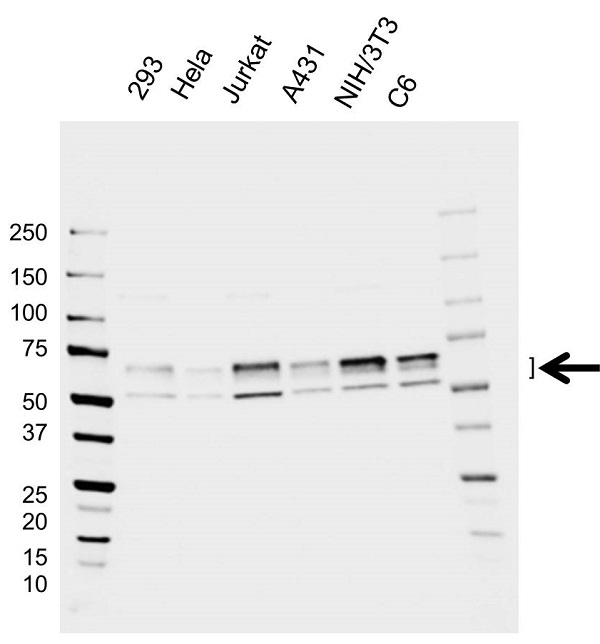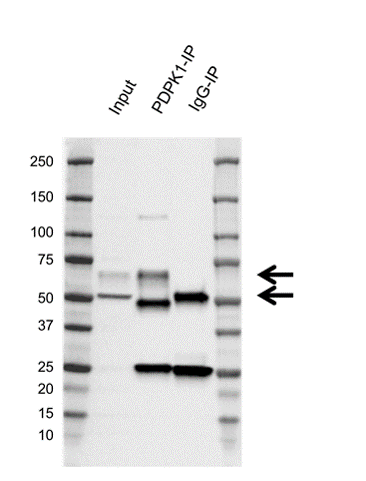PDPK1 antibody | EF01/2H4


Mouse anti PDPK1
- Product Type
- PrecisionAb Monoclonal
- Clone
- EF01/2H4
- Isotype
- IgG1
- Format
- Purified
- Specificity
- PDPK1
| Mouse anti PDPK1 antibody recognizes 3-phosphoinositide-dependent protein kinase 1, otherwise known as PDK1. PDPK1 is a serine/threonine kinase which belongs to the AGC family of protein kinases. The protein plays important roles in cell proliferation and survival, and is crucial for regulation of every step during cell migration (Di Blasio et al. 2017). PDPK1 affects a multitude of downstream processes including PI3K/Akt, Ras/MAPK and Myc signalling, which are often implicated in cancer. PDPK1 controls cancer cell invasion and dissemination, and consistent with this effect, its expression is dysregulated in many cancer types including lung and prostate cancer (Emmanouilidi and Falasca 2017). Targeting PDPK1 has shown to be effective in experimental models with alterations in downstream signalling pathways, and therefore, it has been suggested as a target for cancer therapy (Gagliardi et al. 2018), including the suggestion that PDPK1 inhibition could re-sensitize cancer cells to chemotherapeutic agents (Emmanouilidi and Falasca 2017). |

|
- Target Species
- Human
- Western Blotting
- Mouse anti PDPK1 antibody detects a band of approximately 56–69 kDa in HEK293 cell lysates
- Species Cross-Reactivity
-
Target Species Cross Reactivity Mouse Rat - N.B. Antibody reactivity and working conditions may vary between species.
- Product Form
- Purified IgG - Liquid
- Preparation
- Mouse monoclonal antibody affinity purified on Protein G from tissue culture supernatant
- Buffer Solution
- Phosphate buffered saline
- Preservative Stabilisers
- 0.09% Sodium Azide
- Immunogen
- E. coli-derived recombinant protein of amino acids 411-556 of human PDPK1
- Approx. Protein Concentrations
- IgG concentration 1.0 mg/ml
- Fusion Partners
- Spleen cells from immunised BALB/c mice were fused with cells of the mouse SP2/0 myeloma cell line
- Regulatory
- For research purposes only
- Guarantee
- 12 months from date of despatch
- Acknowledgements
- PrecisionAb is a trademark of Bio-Rad Laboratories
| Application Name | Verified | Min Dilution | Max Dilution |
|---|---|---|---|
| Immunoprecipitation | |||
| Western Blotting | 1/1000 |
The PrecisionAb label is reserved for antibodies that meet the defined performance criteria within Bio-Rad's ongoing antibody validation programme. Click here to learn how we validate our PrecisionAb range. Where this product has not been tested for use in a particular technique this does not necessarily exclude its use in such procedures. Further optimization may be required dependent on sample type.
| Description | Product Code | Applications | Pack Size | List Price | Your Price | Quantity | |
|---|---|---|---|---|---|---|---|
| Goat anti Mouse IgG (H/L):HRP | STAR207P | WB | 2 ml |
|
Log in | ||
| List Price | Your Price | ||||||
|
|
Log in | ||||||
| Description | Goat anti Mouse IgG (H/L):HRP | ||||||
- UniProt
- O15530
- Entrez Gene
- PDPK1
- GO Terms
- GO:0005886 plasma membrane
- GO:0005515 protein binding
- GO:0030036 actin cytoskeleton organization
- GO:0005829 cytosol
- GO:0004676 3-phosphoinositide-dependent protein kinase activity
- GO:0005524 ATP binding
- GO:0005654 nucleoplasm
- GO:0006469 negative regulation of protein kinase activity
- GO:0007268 synaptic transmission
- View More GO Terms
- GO:0008286 insulin receptor signaling pathway
- GO:0018107 peptidyl-threonine phosphorylation
- GO:0048015 phosphatidylinositol-mediated signaling
- GO:0030168 platelet activation
- GO:0031295 T cell costimulation
- GO:0032148 activation of protein kinase B activity
- GO:0048011 nerve growth factor receptor signaling pathway
- GO:0050852 T cell receptor signaling pathway
- GO:0090004 positive regulation of establishment of protein localization in plasma membrane
VMA00817
If you cannot find the batch/lot you are looking for please contact our technical support team for assistance.
Please Note: All Products are "FOR RESEARCH PURPOSES ONLY"
View all Anti-Human ProductsAlways be the first to know.
When we launch new products and resources to help you achieve more in the lab.
Yes, sign me up
